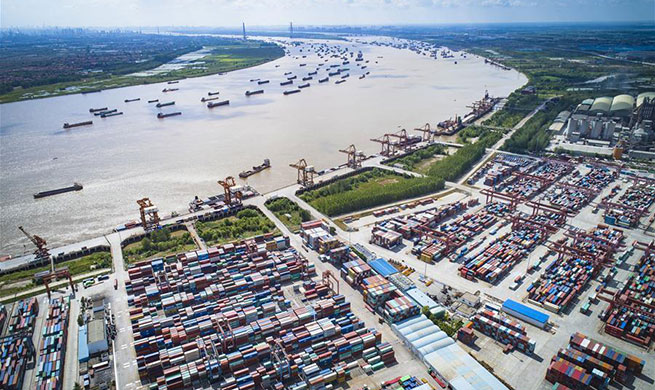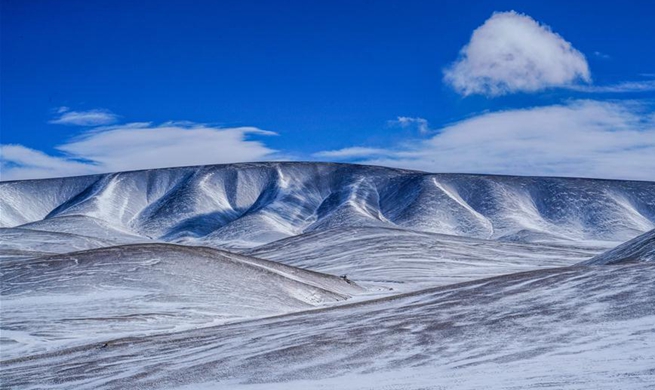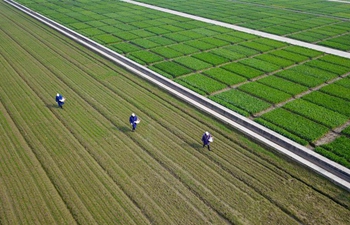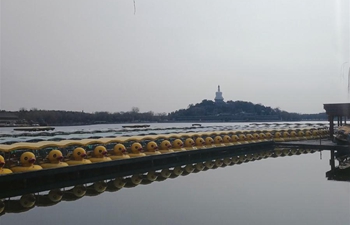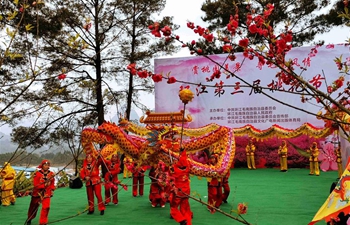KAMPALA, Feb. 26 (Xinhua) -- Isimba Hydropower Plant constructed by Chinese companies in eastern Uganda awaits official commissioning next month after it passed tests from engineers, environmentalists and conservationists.
After commissioning of all the units, the Isimba power plant will generate the installed capacity of 183 MW, which is currently about 19 percent of the country's power generated. The country generates up to 974.84 MW, which experts say is inadequate and expensive.
Constructed along the Nile, the world's longest river, the power plant comes in time to save the country from the thermal-generated electricity of high tariff.
At the peak of the power crisis in 2014, Uganda's government resorted to using diesel generators to power the country's economy, which raised the cost of power.
According to Uganda Electricity Transmission Company Limited, a state-run agency, the cost of thermal power per unit then ranged from 25.28 U.S. cents to 27.08 cents. The cost for hydropower was 12 cents per kWh.
The rising of the electricity costs forced some of the manufacturers to increase the prices of their products.
The intermittent power supply also forced some manufacturers to run their own diesel generators, which also increased their cost of production and later rendered their products not competitive because of the high price.
Economists warned that the inadequate power supply was a key bottleneck to unlocking the country's economic potential.
Uganda's government then resolved to increase hydropower generation in a bid to increase power supply and also reduce its cost.
The construction of the 568-million-dollar power plant started in 2015, after the east African country secured a loan from the Export-Import Bank of China. This was one of the key green energy projects that China undertook to help Uganda fast-track its development.
Another Chinese funded key green energy project is the 600 MW Karuma Hydropower Plant, also constructed along the Nile in northern Uganda.
The government anticipates that both the Isimba and Karuma power plants will address the country's power shortage.
Before construction of Isimba in 2015, the contractor China International Water and Electric Corporation (CWE) was tasked by the government's environmental watchdog, National Environment Management Authority (NEMA), to do an environmental impact assessment.
After wide consultations from responsible government departments, environmentalists, conservationists, academicians and the community that was going to be affected by the project, CWE was given a go-ahead.
"This study was relevant because we had to look at the possible impacts that the project would have on the environment, and social impact as well, and also come up with the mitigation measures before the implementation," Nancy Allimadi, a NEMA official, told Xinhua in a recent interview.
Throughout the construction period, a government multisectoral task force subjected the project to tests and monitoring on a quarterly basis.
"We are going towards the commissioning of the project and we have not had any major environmental damage," she added.
Allimadi said CWE worked with the committee to address any concerns that came up, adding that working with CWE showed that Chinese contractors are putting into consideration environmental concerns in their projects.
"We are pleased that the contractor was listening, we never had any challenging time," said Allimadi, noting that in case any concerns came up they would sit together and devise solutions.
As Isimba nears commissioning, CWE requested Uganda Wildlife Authority (UWA), a state-run conservation agency, to relocate the wildlife that was going to be affected.
Bashir Hangi, UWA's spokesperson, told Xinhua recently that a total of 109 wild animals categorized in nine different species, which among others included snakes and monkeys, were safely rescued and released to a new habitat at neighboring Mabira Forest.
"It was important to relocate the said wildlife species for their protection as their safety could not be guaranteed anymore. We want energy, and developers undertook a detailed environmental and social impact assessment. This assessment usually has proposed measure to mitigate against the impacts of the project. As for wildlife, we relocated the species that were there," Hangi said.







